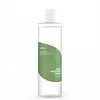What's inside
What's inside
 Key Ingredients
Key Ingredients

 Benefits
Benefits

 Concerns
Concerns

No concerns
 Ingredients Side-by-side
Ingredients Side-by-side

Aloe Barbadensis Leaf Extract
EmollientWater
Skin ConditioningMethylpropanediol
SolventPropanediol
SolventSodium Hyaluronate
HumectantCentella Asiatica Extract
CleansingPolygonum Cuspidatum Root Extract
AntioxidantScutellaria Baicalensis Root Extract
AstringentCamellia Sinensis Leaf Extract
AntimicrobialGlycyrrhiza Glabra Root
Skin ConditioningChamomilla Recutita Flower Extract
MaskingRosmarinus Officinalis Leaf Extract
AntimicrobialPolyglutamic Acid
Skin ConditioningAllantoin
Skin ConditioningDipotassium Glycyrrhizate
HumectantTrehalose
HumectantBetaine
HumectantPanthenol
Skin ConditioningTromethamine
BufferingAcrylates/C10-30 Alkyl Acrylate Crosspolymer
Emulsion StabilisingDisodium EDTA
Hydroxyacetophenone
AntioxidantAloe Barbadensis Leaf Extract, Water, Methylpropanediol, Propanediol, Sodium Hyaluronate, Centella Asiatica Extract, Polygonum Cuspidatum Root Extract, Scutellaria Baicalensis Root Extract, Camellia Sinensis Leaf Extract, Glycyrrhiza Glabra Root, Chamomilla Recutita Flower Extract, Rosmarinus Officinalis Leaf Extract, Polyglutamic Acid, Allantoin, Dipotassium Glycyrrhizate, Trehalose, Betaine, Panthenol, Tromethamine, Acrylates/C10-30 Alkyl Acrylate Crosspolymer, Disodium EDTA, Hydroxyacetophenone
Sedum Sarmentosum Extract 65.33%
HumectantButylene Glycol
HumectantWater
Skin Conditioning1,2-Hexanediol
Skin ConditioningGlycerin
HumectantGlycereth-26
HumectantPolyglutamic Acid
Skin ConditioningHydrolyzed Hyaluronic Acid
HumectantCeramide NP
Skin ConditioningXylitylglucoside
HumectantAnhydroxylitol
HumectantXylitol
HumectantDipotassium Glycyrrhizate
HumectantCitrus Tangerina Peel Oil
MaskingPelargonium Graveolens Flower Oil
MaskingLavandula Angustifolia Oil
MaskingGlucose
HumectantPhospholipids
Skin ConditioningDiethoxyethyl Succinate
SolventCaprylic/Capric Triglyceride
MaskingAmmonium Acryloyldimethyltaurate/Vp Copolymer
Hydrogenated Lecithin
EmulsifyingC12-13 Pareth-9
EmulsifyingDisodium EDTA
Chlorphenesin
AntimicrobialSedum Sarmentosum Extract 65.33%, Butylene Glycol, Water, 1,2-Hexanediol, Glycerin, Glycereth-26, Polyglutamic Acid, Hydrolyzed Hyaluronic Acid, Ceramide NP, Xylitylglucoside, Anhydroxylitol, Xylitol, Dipotassium Glycyrrhizate, Citrus Tangerina Peel Oil, Pelargonium Graveolens Flower Oil, Lavandula Angustifolia Oil, Glucose, Phospholipids, Diethoxyethyl Succinate, Caprylic/Capric Triglyceride, Ammonium Acryloyldimethyltaurate/Vp Copolymer, Hydrogenated Lecithin, C12-13 Pareth-9, Disodium EDTA, Chlorphenesin
 Reviews
Reviews

Ingredients Explained
These ingredients are found in both products.
Ingredients higher up in an ingredient list are typically present in a larger amount.
Dipotassium Glycyrrhizate comes from licorice root.
Extracts of licorice have demonstrated to have antibacterial, anti‐inflammatory, antiviral, antioxidant properties.
One component, glabridin, has extra potent antioxidant and soothing properties. It has also been found to block pigmentation from UVB rays in guinea pigs.
Licorice Root also contains a flavonoid. Flavonoids are a natural substance from in plants. Flavonoids also have antioxidant properties.
Another component, glycyrrhizin, has been found to have anti-inflammatory and antimicrobial benefits. This may make licorice root extract effective at treating acne. However, more research is needed to support this.
Liquiritin is one of the flavone compounds found in licorice. It has been found to help lighten skin by preventing tyrosinase from reacting with tyrosine. When the two react, protein is converted to melanin. Melanin is the substance in your body that gives your features pigmentation.
Licorice root is native to Southern Europe and Asia. It has been used in traditional Chinese medicine to help with respiratory issues.
Learn more about Dipotassium GlycyrrhizateDisodium EDTA plays a role in making products more stable by aiding other preservatives.
It is a chelating agent, meaning it neutralizes metal ions that may be found in a product.
Disodium EDTA is a salt of edetic acid and is found to be safe in cosmetic ingredients.
Learn more about Disodium EDTAPolyglutamic Acid is made up many glutamic acids chained together. It is created from bacterial fermentation.
This ingredient is an effective skin hydrator and may help speed up wound healing. As a humectant, it draws and holds water to the skin. This ingredient is often compared to hyaluronic acid or glycerin. Similarly to hyaluronic acid, it can vary in molecular weights. This means polyglutamic acid is capable of bringing hydration to lower levels of the skin.
Fun fact: Polyglutamic Acid is found in the Japanese food, natto. It is also being used in cancer treatment studies.
Learn more about Polyglutamic AcidWater. It's the most common cosmetic ingredient of all. You'll usually see it at the top of ingredient lists, meaning that it makes up the largest part of the product.
So why is it so popular? Water most often acts as a solvent - this means that it helps dissolve other ingredients into the formulation.
You'll also recognize water as that liquid we all need to stay alive. If you see this, drink a glass of water. Stay hydrated!
Learn more about Water